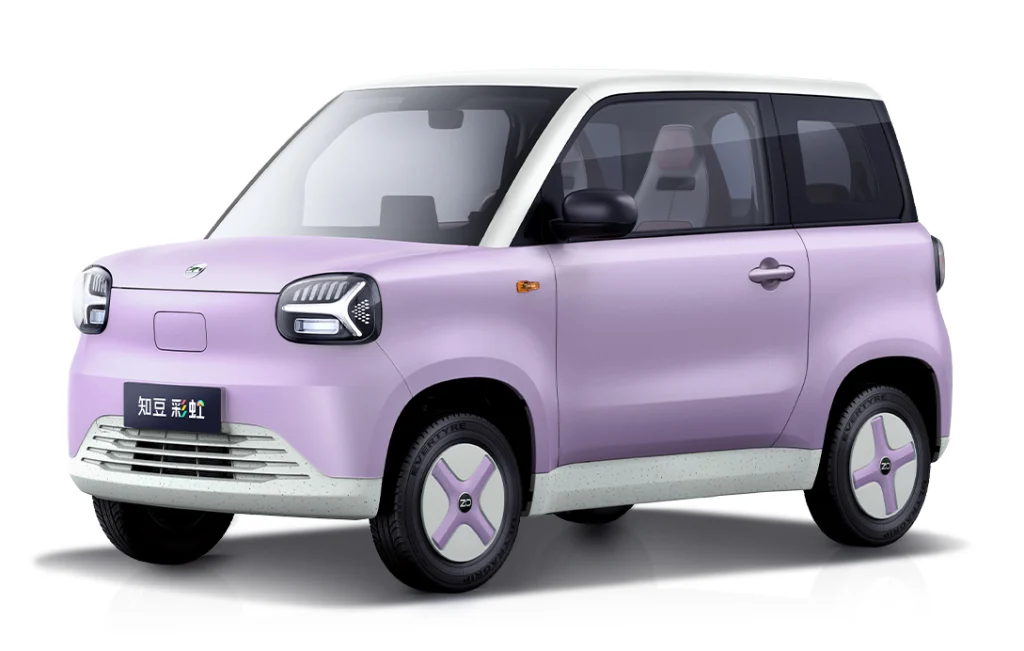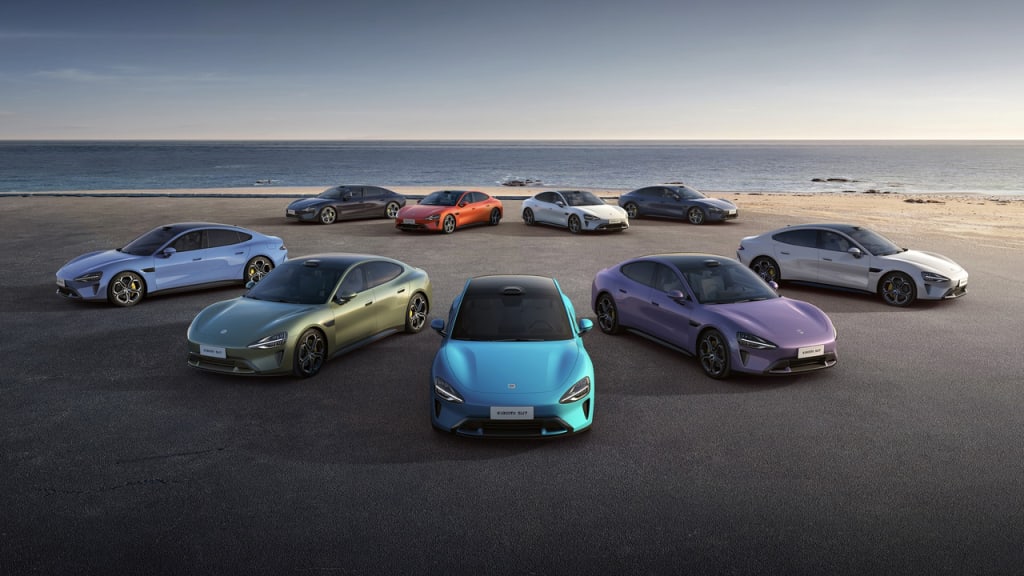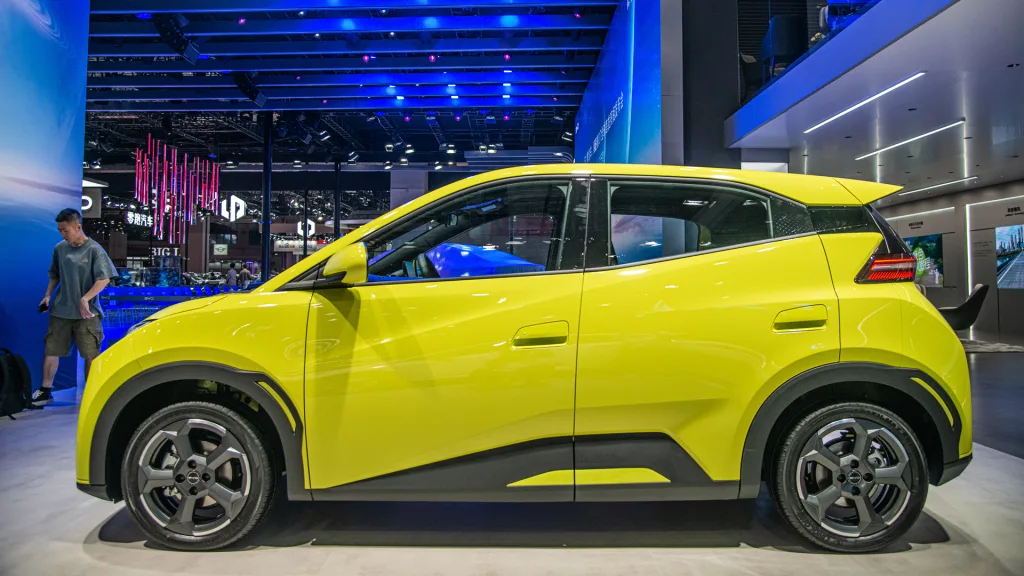A tiny electric car called the Seagull, designed by a former Lamborghini designer, starts at less than $10,000 in China. A version with a battery that can go 250 miles on a charge costs a little more, at $12,000.
The car—made by BYD, the Chinese manufacturer that overtook Tesla as the world’s biggest seller of EVs late last year—isn’t available in the U.S. Neither is the Zhidou Rainbow, another tiny Chinese car that starts at $4,400. More expensive Chinese cars, like the sleek Xiaomi SU7 (which looks like a Porsche, at a fifth of the price) or the XPeng G9 SUV, are also priced to undercut competitors like Tesla. The cheapest EV for sale in the U.S., by contrast, is the $28,000 Nissan Leaf.
New tariffs from the Biden administration make it unlikely that Chinese EVs will be sold in the U.S. anytime soon. But if they had, they almost certainly would have sped up the shift to cleaner transportation.
“If the goal is to try to drive a transition and to get more EVs on the road, putting up trade barriers is counterproductive,” says Michael Lenox, a business professor at the University of Virginia who studies the EV industry.
 Zhidou Rainbow [Image: Zhidou]
Zhidou Rainbow [Image: Zhidou]
CONSUMERS STILL SEE EV COST AS A BARRIER
In a recent survey, more than half of Americans who don’t yet own electric cars said they were interested in buying one. But 64% said cost was a significant barrier.
Ever since Tesla pioneered high-end EVs—recognizing that early electric cars would be more expensive to make, and the luxury market offered more room for margin—other American automakers have also focused more on expensive cars. “The next push will be toward those less expensive categories of cars,” says Lenox. “Clearly, Nissan with the Leaf and Chevy with the Bolt have been playing in that area for a while. But the numbers coming out of China are just game changers.”
That’s not to say that Americans would have necessarily wanted to buy Chinese cars. For decades, American automakers have moved toward bigger, heavier vehicles and away from sedans, arguing that that’s what consumers want.
“With these tariffs, we’re just not going to put that assumption to the test. It’s entirely possible that you could have companies like BYD bringing their low-cost smaller vehicles and American consumers might not be interested,” says Ilaria Mazzocco, a senior fellow at the Center for Strategic and International Studies. “But it’s also possible that consumers might respond in the same way that they have in many other parts of the world, by changing their preferences because the cost is so low, and they’re really efficient, and there are all these other benefits to the vehicles.”
In parts of the developing world, where low-cost Chinese EVs are on the market, the share of electric vehicles on the road is quickly growing. In Thailand, for example, one out of every 10 new car purchases is electric. That’s on par with the rate of EV sales in the U.S., despite the fact that experts once believed EVs would grow fastest in high-income countries and then trickle down to other markets. For the growing middle class in countries like Brazil and Indonesia, someone’s first car is now increasingly likely to be an EV.
 Xiaomi SU7 [Image: Xiaomi]
Xiaomi SU7 [Image: Xiaomi]
A RANGE OF OPTIONS
In the U.S., some of China’s lowest-cost electric cars—with a small size and often limited battery range—might have appealed to consumers in cities with short commutes. (Other cars have incredibly long ranges, like a plug-in hybrid electric car that can drive for 1,300 miles before charging.) And Chinese companies do make larger vehicles that likely would have had broader appeal. “I just got back from China last week, and there were so many different models on the road,” says Mazzocco. “I was in a DiDi, which is the Chinese Uber, in a small electric SUV that looked fairly affordable. I asked my driver about it, and he said, ‘These days you can just get any car you want in electric. Why would you even buy a [gas] vehicle?’” More than 70 new models are coming out this year in China.
The variety of EVs available in the U.S. also keeps growing, and the cost is dropping as batteries get cheaper and manufacturing becomes more efficient. By some estimates, EVs will be cheaper than gas cars, even without any tax credits or other incentives, by 2030. Others say it could happen even faster.
The fundamental design is simpler than a gas car. “You do not have all the systems that you need in an internal combustion engine—you don’t have a coolant system, you don’t have an exhaust system, you don’t have a fuel injector,” says Lenox. “All of these things add cost to the vehicle.” (EVs are also cheaper to operate because electricity is cheaper than gas and because the vehicles need fewer repairs.)
The shift to EVs is happening whether or not Chinese cars are sold in the U.S. But if they were on the market, it would have happened faster. With the world running out of time to tackle climate change, it could have helped cut American emissions faster. Transportation is the biggest source of emissions in the country, and passenger cars and trucks are responsible for most of that pollution.
 [Photo: VCG/Getty Images]
[Photo: VCG/Getty Images]
A SLOWER PACE OF INNOVATION
The Biden administration does want to cut emissions—and by 2030, it wants half of all U.S. car sales to be electric. Still, it’s not surprising that the tariffs exist. Biden worries that if cheap Chinese cars flood the market, American automakers will suffer. (Trump put smaller tariffs in place while in office, and says he also wants to keep Chinese cars out if elected.)
Biden is also concerned that China’s cars, full of smart tech, could be used to spy on Americans. “I’m realistic about the geopolitical moment that we are in with our relationship with China and the concerns about national security risk and even just simply job creation and retention,” Lenox says. China has also given its EV industry massive financial support. Biden argues that’s “unfair,” though arguably if governments boost climate tech—as the U.S. is doing itself in several ways—everyone ultimately benefits.
To help his climate goals succeed, Biden is taking a long-term strategy. Without the support of American car companies and their workers, EVs would struggle. Now, even if Biden were to lose the next election, there are dozens of new factories making EVs and EV parts in such states as Georgia, South Carolina, and Michigan, thanks to requirements for American manufacturing in the Inflation Reduction Act. The existence of those jobs makes it more likely that EVs will continue to grow. But protectionist policies come at a cost.
 XPeng G9 [Image: Xpeng]
XPeng G9 [Image: Xpeng]
“On the one hand, you need to protect these industries,” says Mazzocco. “I think we all know it’s politically untenable that the U.S. just lets the automotive industry go without a fight. But on the other hand, there’s not a great track record for just completely protecting the market and protecting companies, avoiding competition, and ensuring that they’re still innovating. Basically, what’s going to push these car companies to actually make the EVs that people want to buy unless they have some competition?”
In China, intense competition has led to more innovation. Some companies offer battery-swapping, so drivers don’t have to wait to charge their car. Batteries keep getting smaller, lighter, and more powerful. With smaller batteries, there’s more space for storage or legroom. Chinese companies are also moving faster toward self-driving technology, for better or worse. Some innovations are wilder: One hybrid SUV from BYD is designed to work underwater in the case of flash flooding.
The U.S. could have taken the approach that some other countries are taking, encouraging Chinese companies to sell locally without tariffs if they set up local factories. The same thing happened here in the 1980s, when Japanese car companies started manufacturing in the U.S.—and pushed American automakers to improve and become more efficient to compete.
American car companies resisted making electric cars for decades. (GM, for example helped hold the technology back in the 1990s; it’s currently planning to shift fully to EVs.) Now, with bumpy early sales and an uncertain political future, some automakers may want to pull back again. Meanwhile, China’s EV makers are racing ahead.

